
|
Sale 51
Pre-Long Beach Coin and Currency Auction
| Lot |
Photo |
Description |
Realized |
Lot 1517 |
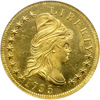 |
1795 $10 Capped Bust. 13 leaves. NGC graded MS-64. A fantastic, intensely Brilliant Uncirculated example exhibiting a needle-sharp strike on a remarkably clean planchet.
This astonishing (and quite beautiful) early eagle traces to the Freedom Collection sold by the firm of Heritage Auction Galleries. In that sale, a foundation of sorts was laid for the coin's historic significance (from which we quote): "The ten dollar gold pieces, given the name 'eagle,' were the largest gold coins produced by the first U.S. Mint from 1795 through 1804. Like all early gold coins, these pieces did not carry an actual denomination as part of the design. John Dannreuther explains: 'The eagle was the second gold denomination struck by the United States Mint. Calling it a denomination is actually a misnomer. Even though a gold eagle was denominated as a ten-dollar coin, our forefathers traded gold by the tale. [Tale, in this instance, means count or tally, a number of things taken together (i.e., the weight and purity of an individual coin).] The weight and purity were the only things important to merchants and individuals -- money was gold, and gold was money. In most cases, transactions of even a nominal sum had to be settled in gold, especially whenever governments were involved. There really was no need at first for a stated denomination on either gold or silver coins, because it was known that our coins would be under extreme scrutiny and would likely be assayed by foreign mints and others as to their weight and purity.'
"In his new reference, Early U.S. Gold Coin Varieties, Dannreuther provides estimated mintages for every variety, as well as estimates of the number of survivors for each variety. The only thing we know for sure is the number of die marriages known from 1795 through 1804 (32) and the total mintage for that period (132,714 coins including 122 pieces reserved for assay). By using the midpoint of Dannreuther's survival estimates, we can also establish an approximate survival rate for the series of 2.5%."
What a low survival ratio! It is no wonder coins like this are the crème de la crème of numismatics in 21st Century America. BD-1 is considered to be the first variety struck in 1795. "Quite a few examples survive in Mint State grades," explains the Freedom Collection description, "giving collectors a reasonable chance of obtaining a high-quality example of the Small Eagle reverse design. Many of the Mint State pieces have Prooflike fields, much like this coin does. Although the fields are not deeply mirrored, they are clearly reflective. The surfaces are exceptional and almost totally mark-free with only a few scattered abrasions. Faint adjustment marks are evident at the center of the obverse, and also on some of the obverse dentils. All of the design elements on both sides are sharply struck, suggesting to some the possibility that this may have been some type of presentation piece. This example is a relatively early die state of the variety, with faint obverse die cracks but no evidence of any reverse cracks. Despite the existence of several Mint State pieces, this example is one of the best…" and indeed it is, an incredible coin, and a first-class opportunity for the earnest buyer of rare United States gold coinage! Pop 1; 2 finer by a point. (PCGS # 8551) .
Estimated Value $350,000 - 400,000.
View details and enlarged photos
Check results on similar lots
| Unsold |
Lot 1518 |
 |
1795 $10 Capped Bust. NGC graded MS-61. Mostly well struck in natural greenish-yellow gold. Free from adjustment marks and just a few die chips noted in the planchet. A lustrous example of our first gold coin. The date on the BD-1 variety is the most closely spaced of the year and the top of the 1 is very close to the curl while the top of the 5 overlaps the bust. Star 11 very near Y with two lumps as top left of Y (these are key identifiers of the variety).
Only a few examples remain in Mint State grades, barely enough to supply the growing cohort of numismatists of means who will have to settle for a bidding tussle to finally obtain one. A fair number of the Mint quality survivors have traces of prooflike fields, much as this coin does. We cannot fail to see this coin becoming anything other than the highlight of a major early gold Type collection. Because 1795 is the initial release of the denomination, the importance of this handsome Mint State 61 example will be established for decades to come. Pop 18; 37 finer.
Historic note: Mintage of only three denominations -- the dime, the silver dollar, and the 10-dollar coin officially called the eagle -- sufficed to commit American coinage firmly to the decimal system in the early days of the U.S. mint. For years it seemed that coinage of these denominations had no other purpose, according to Breen, since they enjoyed little circulation. As it turned out, in the first few decades the Mint's principal output consisted of one denomination in each metal: gold half eagles, silver half dollars, and copper cents. The half eagle seems to have been favored because its bullion value was conveniently close to that of many foreign coins of the period (British guineas and sovereigns, French louis d'or and 24 Livres coins, Portuguese/Brazilian 4,000 Reis and 2 Escudos, etc.); the half dollar because of its size; cents primarily as an alternative to privately made copper tokens. The 10-dollar eagle, though specially named in the Coinage Act of 1792 as our nation's gold monetary unit, was for various reasons inconvenient for international trade.
Estimated Value $90,000 - 100,000.
View details and enlarged photos
| Unsold |
Lot 1519 |
 |
1795 $10 Capped Bust. 13 leaves. NGC graded AU-50 BD-2, R-4+. Light even toning in a new 4 prong NGC holder. Bright yellow-gold luster on satiny surfaces that have some granularity to them due to minor abrasion contact with other coins. There is a short hairline scratch in the field between D and S on the reverse. A touch of weakness is seen at the eagle's breast and legs on the reverse, as well, but here it is probably that a design flaw is the culprit, since the high point of the opposite side lies opposite this area on Small Eagle tens of 1795-97 which often did not allow for sufficient metal flow into the deepest die recesses. The luster that remains is located around the stars and legends mainly, with a few traces of frost in the portrait. Pop 2; 24 finer. (PCGS # 8551) .
Under the terms of the Coinage Act of 1792, the obverses of all the coins, copper, silver, and gold, had to depict Liberty, then as now an allegorical female figure. The reverses of the silver and gold coins had to depict an eagle. With those requirements in force, and a requirement that certain inscriptions appear on all the coins, mint engraver Robert Scot set to work in 1795 on the eagle designs.
The gold eagle obverse depicts a bust of Liberty facing right and wearing a soft cap (not the pileus or Liberty cap found on the Liberty cap half cent and cent, among other U.S. coins). Liberty's hair flows freely, down over her truncated shoulders.
LIBERTY occupies the under border above and to the right of the portrait, with stars arranged along the back of her head and from the Y in LIBERTY to the tip of the bust. The number of stars and their arrangement and exact positioning of LIBERTY vary from year to year.
The first reverse, that of 1795-97, depicts the mandatory eagle, which some believe Scot copied from a sketch or engraving of a first century A.D. onyx cameo held in a museum in Vienna. The eagle holds a small wreath aloft in its beak and a palm branch in its talons. The eagle's wings are outstretched. The inscription UNITED STATES OF AMERICA encircles the design.
Estimated Value $65,000 - 75,000.
View details and enlarged photos
Check results on similar lots
| Unsold |
Lot 1520 |
 |
1796 $10 Capped Bust. PCGS graded MS-62. Boldly struck on a slightly porous planchet with partial reflective surfaces. Glancing over the surfaces, we see impressive soft, smooth luster that radiates its way through the somewhat delicately toned overlay of even light green-gold toning. We look up and down this coin, from side to side and on obverse and reverse, and what do we see? A very pleasing specimen, unsullied and bold. With just the barest hint of weakness near the top portion of the reverse (eagle's neck feathers, and one leg). No contact marks to speak of, and the most saturated toning seems to be confined to the immediate areas around the main design and legends; the coin is remarkably mark-free. This specimen shows every bit of detail on Liberty's profile, and has simply outstanding beauty for a coin from this decade. Very atypical, its visual appeal is far above average. It is far better looking than its grade might suggest, and certainly only a few eagles from this early scarce issue could be considered prettier. A charming specimen of this significant Capped Bust, Small Eagle rarity. Be a sportsman and give it a big bid! Only 4,146 minted. Pop 3; 2 finer in 63. (PCGS # 8554) .
Historic note: Just one die variety is known for the 1796 capped bust eagle. The obverse stars total 16, reflecting Tennessee's admittance as a new state, arranged 8 + 8. LIBERTY is positioned higher on the obverse than on the 1795 varieties, starting from the peak of Liberty's cap (farther left than on the 1795 coin) and ending adjacent her forelocks. The palm branch on the reverse now bears 11 leaves instead of 13 or nine as in 1795. The mintage is 4,146.
Estimated Value $150,000 - 160,000.
View details and enlarged photos
Check results on similar lots
| Realized
$161,000 |
Lot 1521 |
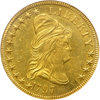 |
1797 $10 Capped Bust. Small eagle. NGC graded MS-63. Mostly well struck on a remarkably clean planchet and shimmering with luster. Medium golden-yellow with some faint hairlines seen only under magnification. Only 55-65 known in all grades. With the exception of the 1795 9 leaf, this is the rarest small eagle $10.00 and is a candidate for finest known.
The early Small Eagle $10 gold pieces are some of the most prized acquisitions in all of numismatics. The Small Eagle type is narrowly confined to just three dates but within that range are several intriguing die varieties, and there really is only one date that can be considered available, the 1795.
The Small Eagle ten dollar pieces were struck in 1795, 1796, and 1797, but the mintage was probably produced only from September 1795 until June 1797. The 16 stars on the obverse of the 1797 eagle are arranged 12 and four. LIBERTY is positioned from just to the right of the peak of Liberty's cap to adjacent to the bridge of her nose. The mintage was 3,615, making this date the scarcest of the three Small Eagle years. A single die variety has the obverse with a fine a die break crossing from the rim through the final 7 in the date and upwards into the bust on all known examples. Another die break extends into the field from the rim below the last star on the right.
The present example boasts beautiful rich luster whose vibrancy is barely diminished by the faint hairlines already noted. Beautiful and rare. Pop 1, finest graded at either service (PCGS # 8555) .
Estimated Value $350,000 - 400,000.
View details and enlarged photos
Check results on similar lots
| Unsold |
Lot 1522 |
 |
1797 $10 Capped Bust. Large eagle. NGC graded MS-61 BD-4. Well struck with plenty of mint luster still intact. A lovely high grade, problem-free specimen and bascially untoned. Only 10,940 minted. No fault can be found with the manner of this coin's preservation and carefully handling after more than two centuries! First year of the Capped Bust, Heraldic Eagle type and a rarity in the series in this outstanding condition. This variety is characterized by a "cross" star arrangement above the eagle and within the semicircle of clouds, with stars 2 through 8 aligned toward the eagle's eye. This variety is even scarcer as a late die state with the die break between ER to the leaf, as seen on this piece. This break undoubtedly led to the early discarding of this die. The surfaces have the usual bright green-gold color with traces of satiny luster intermixed with the semi-reflectiveness in the fields. Sharply struck throughout and well centered on a problem-free planchet with a few of the usual small marks on each side seen on others, the most individual of which is a short diagonal line between L and I of LIBERTY. The overall quality makes this piece appear choicer than the modest MS61 grade usually entails. Pop 31; 17 finer with 13 in 62, 3 in 63, 1 in 64 (PCGS # 8559) .
The long thick necked eagle is a little know subvariety of the Large Eagle type of 1797. It has a different style eagle which makes it sort of a transitional reverse between the tall and short necked varieties. Because these devices were hubbed, the first reverse punch may have been modified to create this subvariety. The long thick neck eagle is unique to this variety, as are the other two eagles for BD-2 and BD-3.
Estimated Value $45,000 - 50,000.
View details and enlarged photos
Check results on similar lots
| Unsold |
Lot 1523 |
 |
1797 $10 Capped Bust. Large eagle. NGC graded MS-61. In NGC holder 1785326-012. Long tapered neck on the eagle. Mostly well struck and loaded with flashy mint luster, particularly so on the reverse. Free from adjustment marks and other defects, just some light handling marks in the exposed fields. A very attractive specimen, all things considered, and noteworthy in many respects for its high condition.
When the small eagle design was revised in 1797, it bore the same obverse as before, but a new reverse, generally known as the heraldic eagle or large eagle.
The eagle gazes to the left on the new design and holds in its beak a ribbon inscribed E PLURIBUS UNUM, a Latin phrase connoting One Among Many. A shield is mounted on the eagle's breast. The eagle holds a bundle of arrows in its right talons (the viewer's left) and an olive branch in its left talons, and is similar to that found on the Great Seal of the United States.
UNITED STATES OF AMERICA encircles the design, as on the small eagle 1797. A semicircle of clouds stretches from wing to wing, with 13 stars positioned between the clouds and the eagle in arrangements that vary from die to die.
Mint engraver Robert Scot's new reverse was introduced on the eagle in mid-1797, so eagles of this year are found with both reverse design types. The estimated mintage of the 1797 capped bust, heraldic eagle $10 is 10,940. Pop 31; 13 in 62, 3 in 63, 1 in 64 (PCGS # 8559) .
Estimated Value $45,000 - 50,000.
View details and enlarged photos
Check results on similar lots
| Unsold |
Lot 1524 |
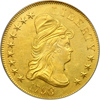 |
1798/7 $10 Capped Bust. 9 stars left, 4 right. PCGS graded MS-62. Well struck with semi reflective surfaces on both sides. Some adjustment lines on the obverse. Highly lustrous. A wonderful coin.
The eagles of 1798 are rarely offered in Mint State grade at public auction, and we are very pleased to be able to offer this stunning Mint State 62 9x4 stars specimen. This lovely example shows the usual greenish-gold tint common to early tens. The obverse has a number of very shallow, horizontal adjustment marks. Because they are so shallow they could be mistaken roller marks (seen on much later issues such as Morgan silver dollars), but since they cover most of that side, and are present on both the devices as well as in the fields, they can only be adjustment marks. Needless to say, they do little to detract from the coin's gleaming overall quality because they are so trivial; nevertheless, we feel mention should be made for accuracy's sake. Slightly weak in the center of the obverse only, the reverse are well impressed everywhere, and there are no obvious or distracting marks or edge bumps that one could speak negatively about. All in all a spectacular 1798 9x4 stars Early Capped Bust Eagle. Pop 1; none finer at PCGS (PCGS # 8560) .
Historic note: Robert Scot's designs for this denomination copied those of the quarter eagle and half eagle. Liberty's fully shaped, draped and capped effigy continued from 1795-97; the heraldic eagle derived from that of the Great Seal of the United States, continued as on the other denominations with the same mistake: the warlike arrows are in the dexter or more honorable claw, outranking the olive branch for peace.
The Eagles of 1798 have only 13 reverse stars, evidently immediately following Mint Director Boudinot's decision to stop adding a new star for every new state.
The two great rarities of this period are the two varieties dated 1798/7. The two deliveries of [900] and [842], Feb. 17 and 28, 1798, are believed to comprise, respectively, Breen-6836 with stars 9 + 4, and Breen-6837 with stars 7 + 6. Coinage of eagles was interrupted thereafter until May 14, 1799. Early breakage of both obverse dies may have been why.
Estimated Value $190,000 - 200,000.
Breen-6836, BD-1.
View details and enlarged photos
Check results on similar lots
| Realized
$178,250 |
Lot 1525 |
|
Withdrawn
Check results on similar lots
| Unsold |
Lot 1526 |
 |
1801 $10 Capped Bust. PCGS graded MS-64. Consistered the most common early eagle thus ideal for a type set. A gorgeous well struck example on a problem-free planchet and loaded with frosty mint luster thoughout.This beauty sparkles with original mint bloom colors of sunset gold. We have seen many 1801 eagles and a curiosity of this obverse die is that it often shows a number of short "spines" in the cap of Liberty -- which are die clash marks from the vertical lines from the shield. The striking quality on this piece is rather striking in its sharpness, if readers will overlook the pun, and shows amazing detaill. This is rare for any early ten insofar as there is complete definition on Liberty's hair waves, the cap, and also on the eagle's breast feathers just above the shield on the reverse (a spot where weakness occurs more often than collectors would like to admit). The mint luster is rich with satiny frost. There is a nice overlay of patina on each side, as described above. Very smooth surfaces are noted, the most obvious evidence of this coin's careful preservation. Sure to be of great interest to collectors who buy early Capped Bust gold, this issue is almost unavailable any finer. Pop 34; 3 in 65 (PCGS # 8564) .
Estimated Value $100,000 - 110,000.
View details and enlarged photos
Check results on similar lots
| Realized
$109,250 |
Lot 1527 |
 |
1841 $10 Liberty. NGC graded AU-58. Nice golden toning. Glowing luster erupts vividly beneath billowing warm golden highlights with at least 75% of the original mint bloom still evident everywhere (in the devices, around the legends, and throughout the wide open fields). An early Liberty Eagle with this amount of mint frostiness adds immensely to its allure. The strike is strong save for a hint of lightness at a few stars. Only 63,131 pieces struck. Pop 15; 13 finer, 5 in 60, 6 in 61, 2 in 62 (PCGS # 8582) .
Estimated Value $4,000 - 4,400.
View details and enlarged photos
Check results on similar lots
| Unsold |
Lot 1528 |
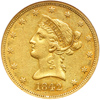 |
1842-O $10 Liberty. NGC graded AU-55. Nice golden toning on both sides. 27,400 struck. Collectors will affirm (after seeing this coin's photographs) that very few early O-mint Eagles look as bold and original as this one. The coin boasts nice, even shades of color, has only minimally abraded fields and devices, and best of all, the rims are unbroken by marks or bumps (a major plus for collectors). Any rug is limited to the high points of the hair and feathers, pointing to the lightly circulated condition in a date that is normally found much more worn. Examination also confirms the grade, there being no areas that criticism needs to focus on. One to expand the collection of any devoted No Motto buyer hoping to lock-in a choice New Orleans Mint 1842 ten. Pop 27; 22 finer. (PCGS # 8587) .
Estimated Value $3,000 - 3,300.
View details and enlarged photos
Check results on similar lots
| Realized
$3,450 |
Lot 1529 |
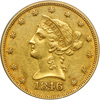 |
1846/5-O $10 Liberty. PCGS graded AU-50. Catalogs in the Red Book for $4,500. Traces of original luster intermix with the light toning to give the coin a special "antique" quality, chiefly blemish-free surfaces of this near-perfect AU50 example. The topmost hair on Liberty complete as is the lovelock streaming down the neck, with similar strong detail on the eagle on the reverse.
At the time New Orleans struck this $10 gold piece, across the Louisiana border in Texas, the U.S. army led by General (later President) Zachary Taylor had its troops encamped in Corpus Christi, Texas as an "Army of Occupation" according to the New Orleans Picayune newspaper for January 15, 1846. This was during the U.S.-Mexican War that year. Pop 10; 10 finer (PCGS # 8596) .
Estimated Value $3,500 - 3,800.
View details and enlarged photos
Check results on similar lots
| Unsold |
Lot 1530 |
 |
1850 $10 Liberty. Large date. NGC graded MS-61. Old holder. Well struck and untoned. This variety more frequently encountered than the Small Date, yet just the same a scarce coin in Mint condition, one that is rare to find better than AU. Its frosty condition is of obvious importance every collector. What's more, the coin is a bit nicer struck on either side than average, we note sharp hair waves and a full hair bun with its beaded cord; the eagle is outstanding as well. The fields are well frosted. There are only a few small blemishes here and there. A visually pleasing coin which should draw much interest from No Motto buyers. Pop 7; 11 finer. (PCGS # 8603) .
Estimated Value $3,500 - 3,700.
View details and enlarged photos
Check results on similar lots
| Realized
$3,220 |
Lot 1531 |
 |
1850 $10 Liberty. Large date. PCGS graded AU-55. Untoned with traces of luster around the devices. Has a curved, shallow line from the chin to the neck. As a date the 1850 is quite plentiful, this in spite of the mintage of 29,451 which suggests otherwise. However, nearly all examples in numismatic hands are worn, typically Very Fine or Extremely Fine, and most tend to be awfully abraded. The present coin is quite choice. Pop 14; 16 finer (PCGS # 8603) .
Estimated Value $1,250 - 1,500.
View details and enlarged photos
Check results on similar lots
| Unsold |
Lot 1532 |
 |
1850 $10 Liberty. Small date. NGC graded AU-58. A hint of light tone. A lightly abraded, mostly untoned example, the reverse shows delicate strike areas on the eagle's neck and on the feather end of one arrow shaft. Crisply struck and problem-free. The scarce Small Date variety Red Books for considerably more than the commoner 1850 Large Date variety. Pop 15; 5 finer. (PCGS # 8604) .
Estimated Value $3,000 - 3,300.
View details and enlarged photos
Check results on similar lots
| Realized
$2,645 |
Lot 1533 |
 |
1859-O $10 Liberty. NGC graded AU-55. Mostly untoned with reflective surfaces. A satiny and still lustrous high-end About Uncirculated Eagle with clean surfaces on both sides that are bereft of the usual nicks and rim bruises. Liberty's cheek is particularly nice here. The strike is virtually complete except at the stars, with strong detail on the eagle's wing and neck feathers along with a bold shield and full claws. Regarding the strike, 1859-O, when it is found (which isn't often) tends to be nicely detailed. A very elusive coin in this grade, for obvious reasons: only 2,300 struck. The 1859-O shares the spotlight, according to experts in dated gold, with the other premier rarity among O-mint Eagles, the 1883-O. Top honors are not as clear-cut as as some would suppose. Pop 5; 2 finer. (PCGS # 8629) .
Estimated Value $18,000 - 20,000.
View details and enlarged photos
Check results on similar lots
| Realized
$25,300 |
Lot 1534 |
 |
1860 $10 Liberty. Our grade is Sharpness of AU-50. Probably cleaned long ago. Lightly abraded. Scarce, as only 15,055 pieces were struck (PCGS # 8631) .
Estimated Value $650 - 700.
View details and enlarged photos
Check results on similar lots
| Realized
$748 |
Lot 1535 |
 |
1863-S $10 Liberty. NGC graded MS-61. A true landmark date in the Liberty No Motto series of $10 Eagles, both in an overall rarity sense as well as in terms of condition availability. A mere 10,000 were struck during the height of the San Francisco Mint's gold rush production (where double eagle totals were many multiples of this figure), with perhaps only 2% or 3% of the original mintage know today, most being heavily abraded and none too attractive. Few can be found even in Extremely Fine condition. This is tied for the finest example known and certified. Only one other piece, a PCGS Mint State 61, comes close. The bright yellow-gold surfaces have a satiny texture and the design elements are finely detailed. A coin with a solid credentials. The only marks of any note are a small nick below the I in UNITED and a series of light abrasions in the field between ES OF and the eagle. Tiny planchet flake below D. of the denomination. A triumph for any specialist in the series to own and admire! Pop 1; none finer at NGC. There is one other at the 61 level, graded by PCGS (the ex Norweb coin last sold, it appears, in a Heritage sale in October 1995) and presumably off the market (PCGS # 8638) .
Estimated Value $20,000 - 22,000.
View details and enlarged photos
Check results on similar lots
| Realized
$37,950 |
Lot 1536 |
 |
1871-S $10 Liberty. NGC graded AU-53. Light golden toning. Another particularly elusive date in all grades, and this coin is probably one of the finesr known to exist from the low original mintage. The surfaces show scattered light abrasions marks, along with a short scuff on the cheek. Liberty's curls and the eagle show mild wear from brief circulation, and the striking quality is acceptable for this date. There are no rim bumps or other surface problems. A classic condition rarity which is certain to draw bids from far and wide. 16,500 minted. Pop 13; 18 finer; 10 in 55; 8 in 58. (PCGS # 8662) .
Estimated Value $4,700 - 5,000.
View details and enlarged photos
Check results on similar lots
| Unsold |
Lot 1537 |
 |
1872-S $10 Liberty. NGC graded AU-58. Lightly toned. A classic elusive date from the 1870s. There were so pitifully few struck of the 1872-S, and most reached circulation, there are not many with this much original luster to go around. One noticeable scratch below the end of the bust. The strike is full and complete with the possibly exception (for those who wish to be choosy) of some softness at one claw and the upper arrow feather; otherwise, the surfaces show only limited circulation marks barring the aforesaid mark, and the upper devices reflect very little actual wear. All in all, that makes this frosty coin a delight for the date collector and a great opportunity for the advanced numismatist. 17,300 minted. Pop 11; 2 finer; 1 in 60; 1 in 61 (PCGS # 8665) .
Estimated Value $5,000 - 5,500.
View details and enlarged photos
Check results on similar lots
| Unsold |
Lot 1538 |
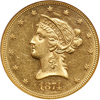 |
1874 $10 Liberty. NGC graded MS-60 Prooflike. Well struck and untoned. The 1874 is one of the very few dates in the 1870s that is seen regularly (thought not commonly) in Mint condition. Sparkling reflective fields and satiny devices. 53,140 struck. Pop 1; 1 finer in 61.
Estimated Value $1,800 - 2,000.
View details and enlarged photos
| Realized
$2,013 |
Lot 1539 |
 |
1874 $10 Liberty. PCGS graded AU-53 PQ. Light gold tone. Some luster visable along with a few abrasions in the fields (a notable one is below the back point of the bust). 53,140 struck. Pop 53. (PCGS # 8669) .
Estimated Value $500 - 525.
View details and enlarged photos
Check results on similar lots
| Realized
$575 |
Lot 1540 |
 |
1875-CC $10 Liberty. NGC graded AU-53. A trifle soft in the centers as made with a few scattered milling marks in the unprotected fields. This lofty-grade 1875-CC is much higher grade than usually encountered.While not the finest certified, it certainly ranks with only a few others in the Condition Census scale. Lustrous honey gold with plenty of brightness in the protected areas. From a modest mintage for the date (see below), with most survivors from that mintage at Very Fine or so. The Winter-Cutler reference calls '75-CC "one of the rarest Carson City eagles from the standpoint of pieces known and rarity." Only 7,715 pieces struck. Pop 7; 3 in 55; 1 in 58; 1 in 60; 1 in 63. (PCGS # 8673) .
Die notes: Date logotype nicely and evenly impressed; well centered horizontally. Left edge of lower serif of 1 over space between dentils. Reverse CC mintmark somewhat to high, both letters over the N in TEN. First C placed closer to talons than N, second C mostly under tip of arrow feather, letters nicely spaced.
Estimated Value $14,000 - 16,000.
View details and enlarged photos
Check results on similar lots
| Realized
$13,800 |
Lot 1541 |
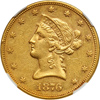 |
1876 $10 Liberty. NGC graded AU-55. Very rare date. Lightly toned with semi reflective surfaces. In a new 4 prong holder. One of only 687 business strikes made for the year, certainly fewer than 20 survive in all grades, this is among the choicer business strikes. Only a single Mint State example (MS61) has been graded by either service. The lightly toned fields show the typical signs of contact from circulation, with some slight reflective quality is retained near the devices. There are a couple of chattermarks near the eye which will serve to identify this coin. It is surprising that this centennial year is so poorly represented by this denomination, apparently the mints experienced demand for double eagles and silver Trade dollars and minor silver coins for production, but not $10 Eagles. Pop 4; 4 finer in 58. (PCGS # 8674) .
Historic note of the 1876 Centennial: One of the high spots of the Centennial Exposition held in Philadelphia in 1876 was the starting of the great 70-foot-tall Corliss steam engine, the wonder of the day, which turned the machinery in Machinery Hall. Dom Pedro, the emperor of Brazil, accompanied by President Ulysses S. Grant, turned on the power which put the huge machine in motion. It was purchaed by the Pullman (railway) Company following the close of the Exposition and for many years ran in its plant at Chicago. Built by George Corliss, it was the largest steam engine in the world. Of engines like the Corliss, William Dean Howells wrote, "In these things of iron and steel the national genius speaks."
Estimated Value $20,000 - 22,000.
View details and enlarged photos
Check results on similar lots
| Realized
$18,975 |
Lot 1542 |
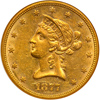 |
1877-S $10 Liberty. NGC graded AU-58. In NGC holder 9173901-008. Rich coppery-golden color. All three mints then in operation struck Eagles in 1877, but only in low numbers. The distinctive San Francisco pieces are all very well executed and, when lustrous, have nice frosty surface as those seen here. Most of the original mintage was not saved, and only a relative few examples are certified in Mint State by either NGC or PCGS. Straw-gold blending into nice rich warm orange-gold color, where glimpses of luster persist within and around all devices extending well into the field on both sides. A couple of minor scuffs at the date with a disturbance in the luster below the first A in AMERICA on the reverse. Only 17,000 struck. Pop 13; 2 finer with 1 in 60, 1 in 61. (PCGS # 8679) .
Estimated Value $10,000 - 12,000.
View details and enlarged photos
Check results on similar lots
| Unsold |
Lot 1543 |
 |
1878-S $10 Liberty. NGC graded AU-58. An untoned coin. Highly lustrous around and within the devices, largely brilliant with gleaming frosty accents on both sides. Always fully struck, with just the outstanding detail at the hair and hair bun, the stars and eagle. 26,100 minted. Pop 25; 5 finer; 3 in 60; 1 in 61; 1 in 64. (PCGS # 8682) .
Two events of note in 1878: the inventor chap, Thomas Alva Edison, took out a patent on the phonograph. Edison, one of the outstanding geniuses in the history of technology, received patent no. 200,521 for his phonograph on February 19, 1878. This patent is just one of the more than one thousand Edison was granted for his inventions.
Also this year, a new vehicle, called "Wheels," appeared in the streets of America. It consisted of a large wheel in front and a small wheel in back, and had a connecting bar and pad upon which the rider could seat himself while he pedaled precariously forward. This was the forerunner of the modern bicycle.
Estimated Value $2,800 - 3,000.
View details and enlarged photos
Check results on similar lots
| Realized
$2,530 |
Lot 1544 |
 |
1881-S $10 Liberty. PCGS graded MS-63. Nice golden toning. Pleasant, almost cheery vibrant gold satin frost display lots of fresh gold color. Probably a good many are not as carefully struck as this '81-S, with no suggestion or even a whisper of weakness at the stars, Liberty, or eagle. Pop 23; none finer at PCGS. (PCGS # 8694) .
Estimated Value $4,000 - 4,200.
View details and enlarged photos
Check results on similar lots
| Realized
$3,680 |
Lot 1545 |
 |
1882 $10 Liberty. NGC graded MS-63. Well struck and frosty. Pop 620; 61 finer; 2 in 63 Star; 57 in 64; 1 in 64 Star; 1 in 65. (PCGS # 8695) .
Estimated Value $700 - 750.
View details and enlarged photos
Check results on similar lots
| Realized
$1,208 |
Lot 1546 |
 |
1883-S $10 Liberty. NGC graded MS-61. Nice golden toning; a lustrous example. With the mints concentrating on the $20 denomination, Eagle production lagged during much of the 1880s, as shown in this figure for 1883-S: 38,000 struck. Pop 18; 11 finer; 8 in 62; 3 in 63. (PCGS # 8702) .
Estimated Value $1,000 - 1,100.
View details and enlarged photos
Check results on similar lots
| Realized
$1,725 |
Lot 1547 |
 |
1884-S $10 Liberty. NGC graded MS-61. Mostly untoned (PCGS # 8705) .
Estimated Value $575 - 600.
View details and enlarged photos
Check results on similar lots
| Realized
$690 |
Lot 1548 |
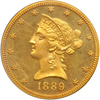 |
1889 $10 Liberty. PCGS graded Proof 63. Old green holder. Lovely golden toning. The obverse shows a scratch near stars 1 to 3. The 1889 is one of the very rare, often overlooked issues in Proof format. It is the rarest Proof Liberty $10 gold of the 1885-1907 years with approximately 12 coins reported out of an original mintage of only 45 Proofs. Creamy gold surfaces eddy and churn with almost mesmerizing reflective finish, while devices are in satin-frosted raised relief. Fully struck in all areas with pinpoint detailing on the tips of the feathers of the eagle and throughout Liberty's hair tresses and coronet. Only 45 Proofs struck. Pop 1; 2 finer in 64. (PCGS # 8829) .
Estimated Value $10,000 - 11,000.
View details and enlarged photos
Check results on similar lots
| Realized
$10,925 |
Lot 1549 |
 |
1891 $10 Liberty. PCGS graded Proof 63 Cameo. Small obverse scratch. Well struck and untoned. On the Proofs this year, the low date slants up slightly on the right. The dangling curl broken away, the missing areas mostly covered by frost. One the reverse, the first four vertical stripes are thinner than the other two. There are die rust marks at N GOD. And finally, some missing feathers below the second white stripe, second and fourth vertical stripes are mainly due to the die polishing; traces of die polish, partly frosted over.
As has been reported by numismatists, the 1891 Proof is as rare as the 1889, with the 1891 existing to the extent of perhaps 20 coins today. It seems logical that many of the 48 pieces minted remained unsold at year's end and were subsequently melted. Apart from the scratch in the obverse field, this razor-sharp piece is a simply glowing example with pronounced cameo contrast and "orange peel" mirrors. Richly frosted. Furthermore, all devices are choice over every feature. Only 48 Proofs struck. Pop 1; 17 finer; 14 in 64; 3 in 65.
Estimated Value $13,000 - 14,000.
View details and enlarged photos
| Realized
$12,075 |
Lot 1550 |
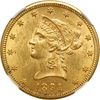 |
1891-CC $10 Liberty. NGC graded MS-62. Mostly untoned with extensive mint frost top to bottom. This is the most affordable way to acquire a frosty Mint condition Eagle struck at the Carson, Nevada mint, one of the most romantic coining facilities in American history (PCGS # 8720) .
Estimated Value $2,000 - 2,100.
View details and enlarged photos
Check results on similar lots
| Unsold |
Lot 1551 |
 |
1892 $10 Liberty. PCGS graded Proof 64 Cameo. A brilliant untoned example with excellent cameo contrast. Only 72 Proofs minted. One might assume the fairly high Proof production of 72 pieces would imply relative availability; however, there are very few high grade 1892 Proof examples that appear in the numismatic marketplace. And unlike dates in the latter half of the 1890s, only a handful of the Proofs of this year show cameo contrast, making the Cameo designation of the present example a bonus. Beautiful bright color, spot-free and with handsome arm's-length eye appeal, plus a bold strike and an absence of marks complete the package. A light toning streak in the lower reverse may have kept this beauty from a higher grade. Pop 2; 1 finer by a single point (PCGS # 88832) .
Estimated Value $20,000 - 22,000.
View details and enlarged photos
Check results on similar lots
| Realized
$18,975 |
Lot 1552 |
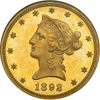 |
1892 $10 Liberty. NGC graded Proof 62 Ultra Cameo. Lovely golden toning on both sides. However you choose to measure it, this is a very scarce Proof ten. The frosted devices and well mirrored surface make for an "ultra" cameo contrast and effective color combination. However, unlike many of the 1890s Proofs, this piece is not among the finest known or certified. Its grade is derived from a small mark in the field below the T of UNITED. It is interesting to see, as well, that it was struck from well-prepared dies that imported a sound and in point of fact, a bold design in all areas.Only 72 minted. Pop 1; 2 finer in 65. (PCGS # 98832) .
Estimated Value $8,000 - 9,000.
View details and enlarged photos
Check results on similar lots
| Realized
$7,763 |
Lot 1553 |
 |
1893 $10 Liberty. NGC graded MS-64. Lovely light gold toning. One would be hard pressed to locate a more pristine attractive MS64 of this year. The richly frosted, rotating gold luster flows evenly to provide a surge of unimpeded mint color. Liberty's face is very choice here. Housed in a new NGC 4 prong holder (PCGS # 8725) .
Estimated Value $1,500 - 1,550.
View details and enlarged photos
Check results on similar lots
| Realized
$1,725 |
Lot 1554 |
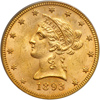 |
1893 $10 Liberty. PCGS graded MS-63. Frosty and untoned (PCGS # 8725) .
Estimated Value $700 - 750.
View details and enlarged photos
Check results on similar lots
| Realized
$1,093 |
Lot 1555 |
 |
1894-O $10 Liberty. NGC graded MS-64. In NGC holder 4513390-007. A fabulous example, well struck and gleaming with semi-reflective mint luster. A most eye appealing eagle exhibiting golden mint bloom color with natural iridescense at the extreme borders. Brilliant and lustrous examples of this issue are rarely offered. The devices being frosty and the fields exhibiting a form intermediate between frostiness and prooflike, the effect is most desirable. As expected, design features are sharp including the feathers on the eagle's legs, tail, wings, and neck. This piece is also noteworthy as one of the few high grade survivors from the small mintage at New Orleans. The presently offered MS64 specimen also happens to be among the finest known as is readily confirmed by the population data: Pop 2; 1 finer by a point (PCGS # 8730) .
Estimated Value $10,000 - 12,000.
View details and enlarged photos
Check results on similar lots
| Realized
$9,775 |
Lot 1556 |
 |
1894-O $10 Liberty. NGC graded AU-58. Nice golden toning with semi-reflective fields and luster in the protected areas. Only 107,500 minted (PCGS # 8730) .
Estimated Value $500 - 525.
View details and enlarged photos
Check results on similar lots
| Realized
$575 |
Lot 1557 |
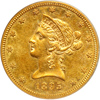 |
1895-S $10 Liberty. PCGS graded AU-55. Light golden-orange toning with extensive luster evident around the devices. Only 49,000 minted. In an old green label holder (PCGS # 8734) .
Estimated Value $600 - 650.
View details and enlarged photos
Check results on similar lots
| Realized
$719 |
Lot 1558 |
 |
1896 $10 Liberty. PCGS graded MS-64. Lovely light golden and orange toning over frosty mint luster. Scarce, low mintage year: 76,270 pieces. Rarely offered with such attractive, blemish-free surfaces, since 1896 tends to come heavily marked. We suggest a strong bid will be required. Pop 7; none finer at this service (PCGS # 8735) .
Estimated Value $2,500 - 2,600.
View details and enlarged photos
Check results on similar lots
| Realized
$2,875 |
Lot 1559 |
 |
1897 $10 Liberty. NGC graded MS-63. Frosty and untoned. American gold coins of the 19th century like this lovely 1897 Ten, because of increased off-take by collectors and gold hoarder in recent months, have seen a remarkable drop in availability. Bidders will more than welcome this coin's attractive appearance (PCGS # 8737) .
Estimated Value $700 - 750.
View details and enlarged photos
Check results on similar lots
| Realized
$1,035 |
Lot 1560 |
 |
1899 $10 Liberty. NGC graded Proof 64 Cameo. Lovely golden toning on both sides. In a new NGC 4 prong holder. A lovely and choice Proof example with nice cameo contrast. The devices are luminous with brilliant yellow-gold color, while the fields are fully and smoothly reflective. In addition, the surfaces have only a few hairlines and flakes in the field. Soft-edged devices and lettering throughout the centers are sometimes seen on various dates of this issue; however, a fair percentage of this year's production in particular is found with needle-sharp detail to be called "bold" and this is one such coin! Right at the cusp of Gem quality. Only 86 struck. Pop 11; 13 finer; in 65; 2 in 66; 2 in 67. (PCGS # 88839) .
Estimated Value $13,000 - 14,000.
View details and enlarged photos
Check results on similar lots
| Realized
$16,100 |
Lot 1561 |
 |
1900 $10 Liberty. NGC graded Proof 67 Cameo. A wonderful Gem Proof gold coin. Looks like a perfect coin. As a matter of fact, this is indeed a magnificent, fully struck and pristine superb gem, the quintessential Proof Eagle. Virtually flawless and displaying incredibly intricate detail, we repeat, it stands head and shoulders above the competition. Both sides of this piece (unlike a few Proofs which are not quite fully struck) are a marvel of precision minting. The technical perfection shows in all regions: crisply detailed including the cameo-frosted centers. One of only three in this grade and could easily be the finest known by the looks of it! Only 120 Proofs struck. Pop 3; none finer at NGC. (PCGS # 88840) .
Estimated Value $85,000 - 90,000.
View details and enlarged photos
Check results on similar lots
| Unsold |
Lot 1562 |
 |
1901 $10 Liberty. PCGS graded MS-63. Old green holder. Nice golden toning (PCGS # 8747) .
Estimated Value $700 - 750.
View details and enlarged photos
Check results on similar lots
| Realized
$1,035 |
Lot 1563 |
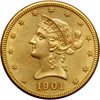 |
1901 $10 Liberty. Sharpness of AU-50. A few light hairlines, but satin luster still adheres.
Estimated Value $400 - 425.
View details and enlarged photos
| Realized
$604 |
Lot 1564 |
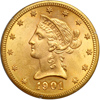 |
1901-S $10 Liberty. PCGS graded MS-63 PQ. Housed in a First Generation Holder. Lovely rich golden toning atop booming luster consistent with the high standards for 1901-S Libety Eagles (PCGS # 8749) .
Estimated Value $1,100 - 1,200.
View details and enlarged photos
Check results on similar lots
| Realized
$1,610 |
Lot 1565 |
 |
1901-S $10 Liberty. NGC graded MS-63. Well struck with light golden color. Extra frosty cartwheel luster (PCGS # 8749) .
Estimated Value $700 - 750.
View details and enlarged photos
Check results on similar lots
| Realized
$1,150 |
Lot 1566 |
 |
1902-S $10 Liberty. NGC graded MS-65. Nice original golden toning on both sides. This exceptionally pleasing MS65 example has rich color over each side with dazzling luster typical of the San Francisco Mint's other gold coins struck at the turn of the 20th century. The device is typically strong, with clear definition to the high points of Liberty's hair and hair bun, as well as to the high points of the eagle's wings, neck feathers, and shield. A beautiful gem! Pop 119; 17 finer; 11 in 65 Star; 15 in 66; 1 in 67. (PCGS # 8751) .
Estimated Value $4,500 - 5,000.
View details and enlarged photos
Check results on similar lots
| Realized
$4,255 |
|
|